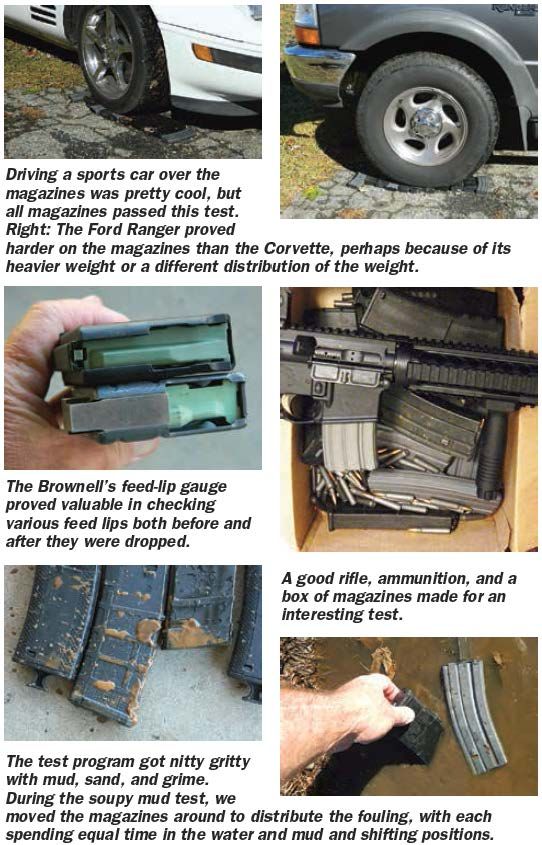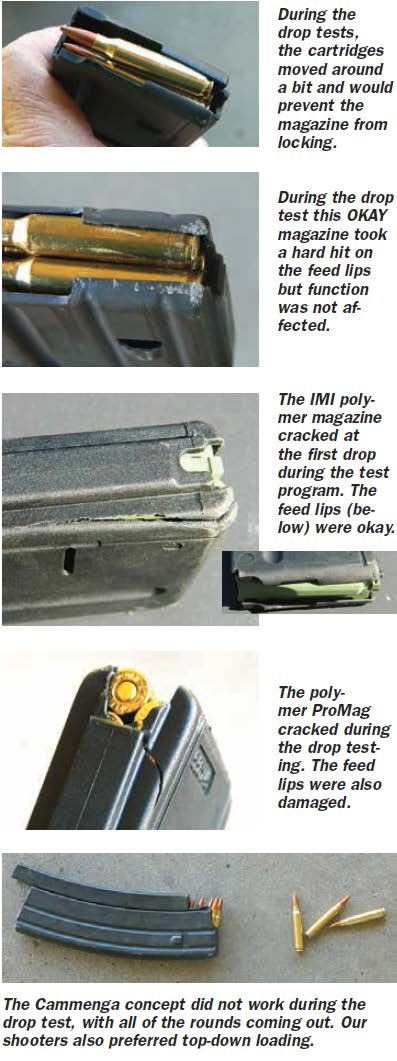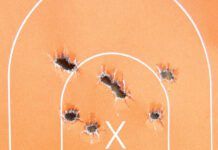A rifle is only as good as the magazine it uses and the ammunition it is fed. The feed device is the heart of the rifle. Magazines are made in many variations upon the same design – a box with a spring and follower. Some are made to be as reliable as possible; others are built as cheaply as possible, and most are designed to function and are priced competitively. But as we found in this report, not all AR-15 rifle magazines can withstand tough testing.

The test program took some time to design, and were indebted to Larry Weeks at Brownells for passing along some critical advice on how to separate the wheat from the chaff regarding magazine durability and function. Producing a tough test protocol is important because these are not simply sporting magazines.
Sure, they will be used hard in 3 Gun competition and maybe the national matches. And hunters may drop a magazine from a deer stand or a varmint blind. But our protocol strongly considered the needs of peace officers who privately purchase the AR-15 rifle; they will bet their lives on the rifle, ammunition, and magazine – and you may do the same in an emergency.
We had three pieces of each test magazine, and they were grouped into polymer and metal bodies. The 10 polymer magazines were Command Arms Accessories 30-Round Polymer Magazine, $12.34; IMI Defense Polymer 30-Round AR-15 Magazine, $11.97; ProMag Industries 30-Round Black Polymer Magazine, $15.45; Command Arms Accessories AR-15 Countdown Magazine, $13.52; SIG Sauer AR-15 30-Round Polymer MAG55630BLKP, $20; S.W.T. 30-round AR-15 Magazine, $17.99; Thermold Master Molder Magazine 30 Round M16/AR-15 M16AR1530, $10.59; Troy Industries Battlemag Magazine AR-15 30-Round Polymer, $14.29; Magpul AR-15/M16 PMag Gen M3 MAG557BLK, $14.20; and the Magpul PMag 30 AR/M4 Window Gen M3 MAG556BLK, $17.05.
The five metal body-units were Cammengas AR-15 Easymag 30-Round EM3556, $21.99; ProMag Industries 30-Round Blue Steel Magazine, $18.31; OKAY Industries USGI 30-Round AR-15 Magazine, $8.99; NHMTG AR-15/M16 30-Round Magazine MA02L, $19.99; and the Brownells 30-Round Gray AR-15/M16 Magazine w/SS Spring 200200, $9.99.
One of the surprising things we found during the test was that price had little to do with quality and performance – a contradiction in what we usually find among guns.
How We Tested
One thing for certain – magazines will not last forever, and in most cases, their useful life is far less than that of a quality AR-15. So our test procedure was designed to accelerate a lifetime of wear and hard use.
Prior to the torture tests, we used a Brownells magazine lip gauge. (#080 000 744WB) to ensure that the magazine lips were in specification before we proceeded. Brownells technicians cautioned that the gauge may not be applicable to polymer magazines, but we tested each with the gauge both before and after impacts as well. The magazine lip gauge had to enter the space between the feed lips with light pressure. By the same token, it could not simply drop into the space between the magazine lips.
For function checks, we used two proven guns, a Bushmaster standard carbine and a Daniel Defense rifle. To begin, we made certain that all pins were flush with the receiver, the hammer pins were properly in place, and that the carrier keys were properly staked to forestall rifle-related malfunctions. The rifles were well lubricated during the firing tests. Neither rifle has exhibited a malfunction of any type in the past, and each had well in excess of 3,000 rounds of ammunition through them before the test began.
Heres the test program in more detail:

Test 1
With unloaded rifles, we inserted an empty magazine to check for fit and lock. Next, we pressed the bolt to the rear to ensure that the follower properly locked the bolt. Next, with the bolt closed on the rifle, we ejected the empty magazine.
Test 2
We inserted loaded magazines into the rifles to be certain they locked correctly. Next, we pressed the magazine release and made certain the magazine dropped freely. We also carefully worked the bolt and made certain the first round loaded cleanly.
Tests 3 and 4
Using fully loaded magazines, we dropped each magazine down a tube to control its orientation. First, we dropped them on the feed lips, then on the base. Each magazine was dropped three times. If a round was lost, it was replaced for the subsequent drops.
As a point of interest, of the eleven types of magazines that continued the test at this point, the PMag window magazine and Brownells mag lost only two rounds. The NHMTG 20 round, the NHMTG 30 round, the OKAY magazine, the PMag and the S.W.T. lost a total of three rounds to this point. The SIG lost 7, followed by the Master Molder at 8, the Troy 9, and the Countdown 13.
Test 5
A 210-pound tester wearing Danner jump boots leapt from a 3.5-foot-tall platform onto each magazine body, attempting to hit dead center of the magazine. After the magazines received this shock, they had to lock into the rifle, eject normally when the magazine release was manipulated, and also feed the first round normally. Though the jump test was considered an important impact test, it did not affect the magazines.
Test 6
We slowly ran over the loaded magazines with a Chevy Corvette and a Ford 4WD Ranger. The heavier Ranger caused rounds to pop out of the CAA Countdown, SIG, and S.W.T., but they remained functional. They were not eliminated at this point, but we rated them down for their cartridge losses.
Test 7
The surviving magazines were loaded with a full complement of Tula (steel-case) 55-grain FMJ ammunition and dropped in soupy mud. We picked up each magazine, shook it dry, then we rushed to the muddy range for a test firing. The CAA magazine failed to feed in this test and was eliminated.
Test 8
We reloaded the magazines with Remington 55-grain FMJs and let them sit submerged in water for 24 hours. Then we drained them and checked for spring corrosion and function. This didnt affect function.
Test 9
We cooked the unloaded magazines in full sunlight for a day. None changed shape or configuration. The metal magazines were hot to the touch. All locked into the rifles.
Test 10
We loaded the magazines with steel-cased ammunition and placed them in a freezer for 24 hours. Water was not involved, so there was no icing. The polymer magazines felt stiff to the touch, but none malfunctioned, feeding the first round with no issues.
Firing Tests
Finally, the magazines that survived the physical tests were subjected to a rapid-fire test program with three different types of ammunition to be certain they fed properly. The ammunition types included Tula steel case, Remington brass case FMJ, and Remington brass case JSP. It is asking a lot for a magazine to properly feed a column of 20 to 30 cartridges from heavy compression when fully loaded, to almost no compression when the gun load is almost expended.
At this point, we would caution our readers against running similar tests – it gets very expensive. However, we are certain some will run tests similar to these on their personal magazines. If you do so, we urge you to be careful. In particular, during the drop tests of loaded magazines, we noticed that many bullets were pushed deeper into the cartridge case. Cases were dented, and crimps were broken from the force. Of course these cartridges were discarded. They would not have fed correctly, and pressures would have been driven dangerously high.
Heres how the magazines performed individually, moving from worst to best as they were eliminated:
Command Arms Accessories 30-Rd. Polymer, $12.34(CheaperThanDirt.com #8-CAA-MAG)
This magazine is similar to the Countdown, but without the slot for viewing cartridges. It disassembled on the third drop onto the feed lips.
Gun Tests Grade: F
Cammenga AR-15 Easymag30-Round EM3556, $21.99(ImpactGuns.com #718122544158)
This magazine features a sliding component that allows easy loading of the magazine. However, a certain amount of effort is required to operate the magazine, and most of us prefer conventionally loading a magazine. The magazine did not pass the feed-lip drop test when its sliding door opened and dumped the magazine load.
Gun Tests Grade: F
IMI Defense Polymer 30-RoundAR-15 Magazine, $11.97(CheaperThanDirt.com #MAG-790)
This magazine failed the drop test by losing the ammo load on the first drop. Upon examination, we found the magazine body was cracked.
Gun Tests Grade: F
ProMag Industries 30-RoundBlue Steel Magazine, $18.31(PromagIndustries.com #COL-A1)
During the feed-lip drop test, the feed lips were crushed and the rounds could not be unloaded without a screwdriver. Also during the feed-lip drop, the base plate was damaged and bulged by the impact.
Gun Tests Grade: F
ProMag Industries 30-RoundBlack Polymer Magazine, $15.45(PromagIndustries.com #COL-A18)
During the first drop test this magazine lost 2, 10 and then all of the cartridges loaded. The true damning part of the evaluation was that the magazine was cracked and non functional after the test.
Gun Tests Grade: F
Command Arms Accessories AR-15Countdown Magazine, $13.52(CheaperThanDirt.com #2-MGCAACDMAG12)
We liked the countdown feature, a window in the magazine that helps keep track of cartridges. This magazine fared well early on, but it lost more rounds than the others during the drop tests and when vehicles ran over it. Even though it lost rounds in the vehicle test, we carried it over to the firing tests. During the first firing test, the magazine refused to feed properly and seemed stiff going into the magazine well, possibly because the magazine lips had spread.
Gun Tests Grade: F
SIG Sauer AR-15 30-Round PolymerMAG55630BLKP, $20(CheaperThanDirt.com #8-SIG-MAG55630BLKPLY)
This magazine fared well during the early testing, but lost rounds when run over with the vehicles. However, we reloaded the rounds, and the SIG made it to the firing tests and passed.
Gun Tests Grade: B
S.W.T. 30-round AR-15 Magazine, $17.99(SportsmansGuide.com #WX2-292179)
This was a well-made magazine that sailed through early testing. However, during the vehicle testing it lost a number of rounds. It passed the firing test.
Gun Tests Grade: B
Thermold Master Molder Magazine30 Round M16/AR-15 M16AR1530, $10.59(CheaperThanDirt.com #57872)
These were one of the least expensive magazines tested. To our surprise, these magazines made it to the big time. With the absence of a discernible feed lip compared to some magazines, the polymer magazines should feed well, but in the end begin to lose tension earlier, as examination of well-used versions of this magazine indicates. The Master Molder made it to the firing test and malfunctioned with steel-case ammunition.
Gun Tests Grade: B
Troy Industries Battlemag Magazine AR-1530-Round Polymer, $14.29(MidwayUSA.com #859891)
The Troy Industries Battlemag is an advanced polymer 30-round magazine. The polymers used in the magazine are chemical, biological and impact resistant. The feed lips have been reinforced and the mag uses an anti-tilt follower. The mag body features a aggressive scale texture that provides a sure grip but will also extract from magazine pouches easily. The spine of the magazine is designed to prevent over-insertion common with some polymer mags. The floor plate features a shock absorbing pull tab, or can be used with the flush locking plate. Functions with all M4, M16, AR-15, HK416, and FN SCAR rifles.
The Troy magazine made it to the top of the list just below the NHMTG, PMag and OKAY magazines. This is based upon the fact that the Troy Mag lost more average rounds – a total of 9 – during drop testing. It did not crack, however and remained functional. It lost no rounds during the vehicle testing. Having passed all other testing and surviving until the firing test, the Troy Mag is a robust and reliable magazine.
Gun Tests Grade: A-
OKAY Industries USGI 30-Round Mag, $8.99(Gunsamerica.com)
The OKAY magazines gave excellent results. They were tied with the NHMGT magazines, and the Brownells in practical terms was no better. The only slight mark against the OKAY was that in corrosion testing, these magazines picked up a light dusting of red rust the others did not, but function wasnt affected. The OKAY magazines may have been older than the others tested.
Gun Tests Grade: A-
NHMTG AR-15/M16 30-RoundMagazine MA02L, $19.99(Brownells.com, #100-012-166WB)
We tested both 20-round and 30-round NHMTG magazines, both of which made it to the end of the test. However, by the time this issue came out, the 20-round versions were no longer available from Brownells. Function was good and so was durability. These magazines, the OKAY magazine, and the PMag tied for second place by a narrow margin, based on the aggregate number of rounds they lost during various phases of testing.
Gun Tests Grade: A
Magpul AR-15/M16 PMag Gen M3MAG557BLK, $14.20(Brownells.com #100-011-220WB)
The PMag was the top performer among the polymer magazines. Ease of disassembly and general handling were a big plus.
Gun Tests Grade: A
Magpul PMag 30 AR/M4 Window Gen M3MAG556BLK, $17.05(Brownells.com #100-011-219WB)
Despite the use of a slide window, which theoretically weakens the magazine body according to some opinions, the PMag with window actually performed slightly better than the standard PMag, losing fewer total rounds during the test program. When run over by vehicles, this unit and the window did not crack.
Gun Tests Grade: A
Brownells 30-Round Gray AR-15/M16Magazine w/SS Spring 200200, $9.99(Brownells.com #078-000-113WB)
These magazines are very similar to the models that Brownells supplies to the US Military. All components are made of mil-spec materials and are manufactured under strict, ISO quality control standards. The heat-treated, welded aluminum body is hard-anodized for superior corrosion resistance, then given a tough, dry-lube coating to eliminate the need for additional lubricants that would attract dust, sand, or dirt. The latest military-type, glass-fiber reinforced composite follower further guarantees flawless feeding in the harshest tactical conditions. We tested the mil-spec stainless-steel spring, but a version with a high lubricity dry-lube-coated chrome silicon spring is also available. They are affordable, well made, and reliable.
Gun Tests Grade: A
Our Team Said
Test 12 was the final test we ran, taking the winners through the first 11 rounds and leaving them fully loaded for a month at full compression. Then we ran more shooting function tests and found there were no feed or fire issues with any of the remaining magazines. In our view, the Brownells, NHMTG, and OKAY magazines are excellent examples of aluminum magazines. All of them were easy to maintain, proven to be reliable, and are competitively priced. If you prefer polymer bodies, the PMags were both top choices, with the cartridge-counter window option giving that model the edge over the regular PMag. The Troy was also a good choice. If we were buying AR-15 magazines, we would decide whether we wanted aluminum or polymer bodies, then shop the top-ranked items for the best price.
Written and photographed by R.K. Campbell,using evaluations from Gun Tests team testers. GT



















Have you done a review of AR-15 Magazines in the last decade?